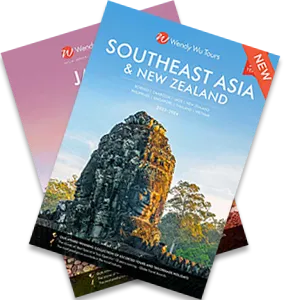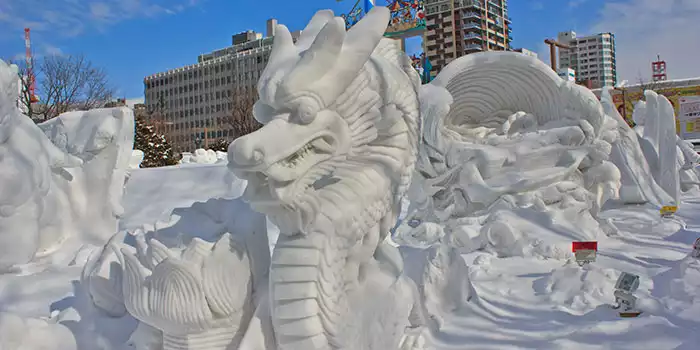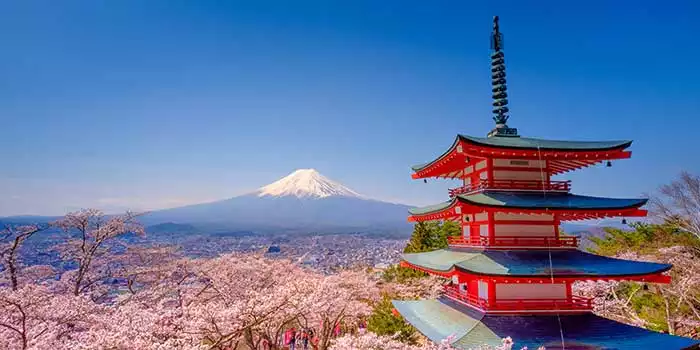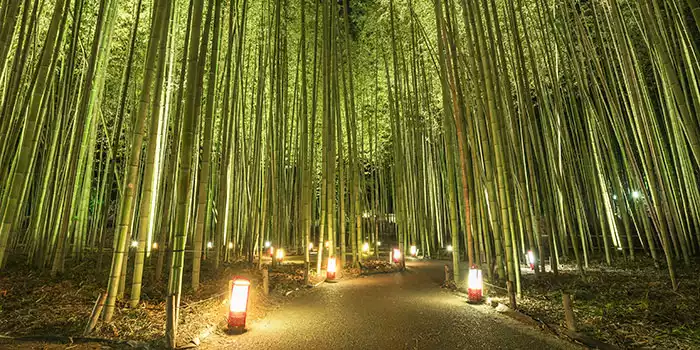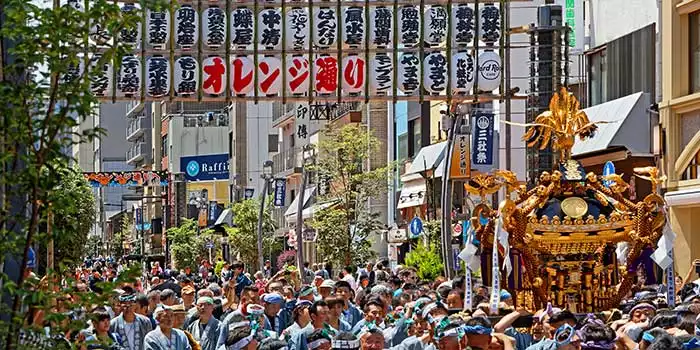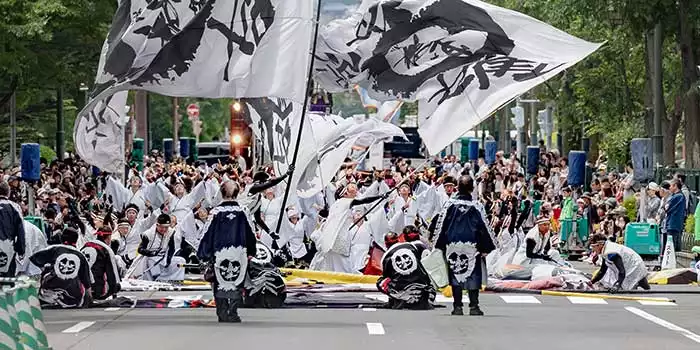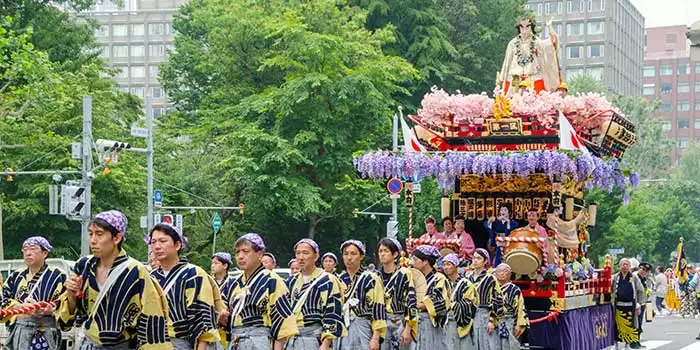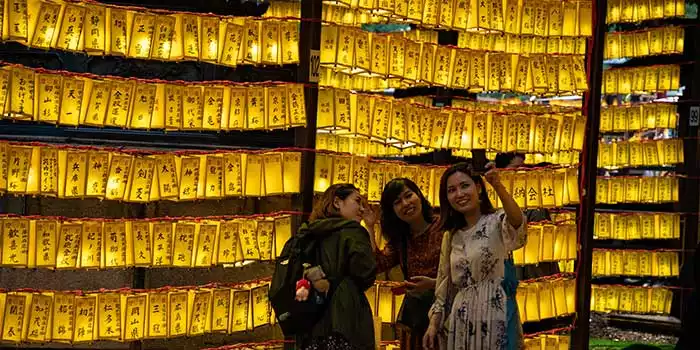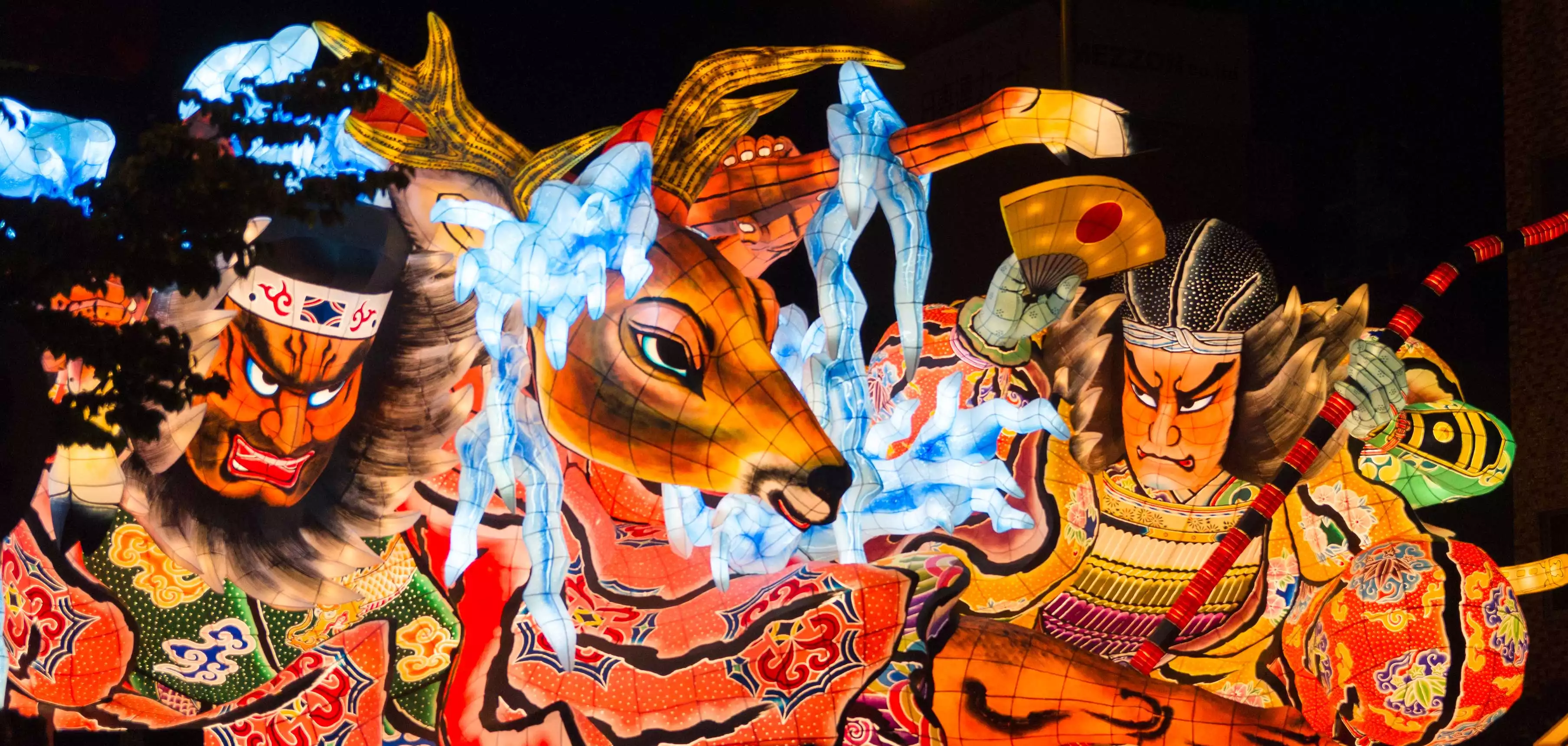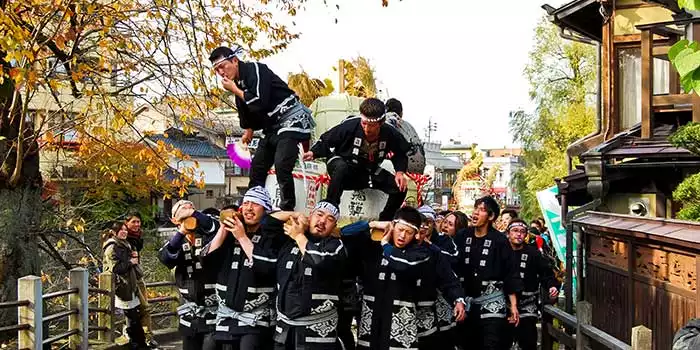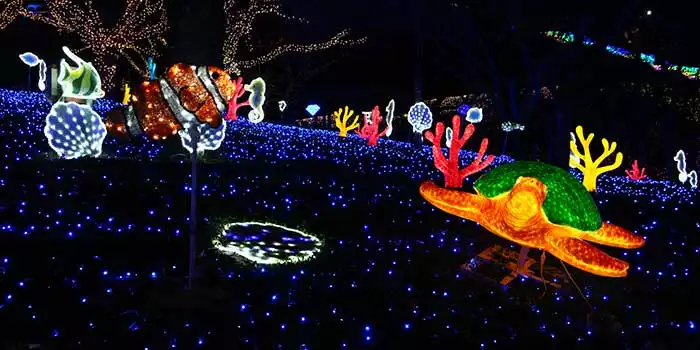
Discover the best time to go to Japan with Wendy Wu Tours
The best time to visit Japan is during spring (March to May) when the cherry blossoms are bursting into life and autumn (September to November) when the scenery is ablaze with colour.
Having said that you can enjoy Japan holidays year-round, with four distinct seasons, each of which has its own unique charms. Stretching 3,000 kilometres from end to end, the Japanese archipelago reaches from the tropical south to the cold and mountainous north, so the weather can range wildly throughout the year.
The spring (March to May) brings with it the famous cherry blossoms, or sukura and is many's people's pick for the best time to vist Japan. Gazing on the sea of soft pink flowers it’s easy to see why both locals and international travellers are so enamoured; in the two weeks after they first bloom, locals and visitors alike stroll, sit and picnic beneath the laden boughs.
Japan’s deep and rich autumn (September to November) is almost equally beguiling. In the parks and temple gardens of the cities, the leaves of the maple and gingko trees turn vibrant shades of red, yellow and orange; if you are travelling into the Japanese Alps, you’re in for an even more spectacular sight.
Japan’s summer (June to August) may be hot and humid but it is the season for festivals and fireworks. Enjoy impromptu celebrations or escape to the mountains to find the cooler climes and maybe do some hiking – between July 1 and August 31 is the only time of year that you are able to climb Mt Fuji.
In the winter (December to February), outside the cities, the country becomes a snow-covered wonderland. Vibrant ski resorts?spring into action, ice festivals take place and the Japanese macaques earn their snow monkey moniker. Oh, and there is nothing better than the glorious warm waters of an onsen on a cold winter’s day!
To help you decide when is the best time to travel to Japan for you, read more about Japan’s climate by month, and check out some fantastic events you could experience on one of our tours.

Discover the Spirit of Kyushu on this immersive 11-day tour, designed especially for second-time visitors to Japan. Journey beyond the classics to explore the island’s volcanic landscapes, tranquil onsen towns, and rich cultural traditions—all in a small group setting with expert guides.
Generally dry and sunny with cool temperatures, in Japan’s northern reaches, and in the mountainous areas throughout you’ll find a good amount of snow perfect for skiing. This month, all the most popular tourist attractions will be quiet.
The Japanese New Year celebration, Oshogatsu is the most important holiday of them all. Over the first few days of January, families gather together to see in the New Year – seen as a fresh start. Doorways are decorated with foliage, and all clothes and houses are cleaned, a visit is paid to a shrine and special foods are consumed.
Similar to January – dry, sunny and cool. The snow continues to be plentiful and excellent for skiing, in fact, this is the peak month for swishing down the slopes of Japan’s plentiful ski resorts. The sights continue to be quieter in terms of visitors.
In February, sculptors from all over the world descend on Sapporo to compete in the Snow Festival, creating huge and intricate sculptures of all manner of things! One of the largest events of its kind in the world, the icy creations take over Odori Park for seven days.
See it on a Tailor Made Tour.
In March the weather begins to warm up and the plum blossoms spring into action, signalling that spring has arrived. The cherry blossoms begin to bloom in the warmer south of Japan and gradually sweep up the country, reaching places like Kyoto and Tokyo in the last days of the month. This is a very popular time to visit Japan, but worth it for the beautiful blossoms and the festivities that come along with it.
As spring creeps around the corner, Japan begins to be coated in a beautifully subtle pink mist, as the cherry blossom, or sakura, paints the country with a pallet of delicate colours.
Beginning in Okinawa in the south, the cherry blossom in Japan starts to spread north through the main islands in March and April before reaching Hokkaido in early May. The arrival of the blossom varies depending on the weather, but this time does see the country absorbed in the excitement of the upcoming blossom.
A lovely celebration in Kyoto, Hanatoro sees beautiful lanterns lighting up the streets to Kiyomizudera Temple, whilst other temples put on lavish light displays and illuminations to.
A sumo tournament is held in Osaka in March, lasting for 15 days, giving you the perfect opportunity to see this ritual-filled and fascinating sport in action.
Talk to our Tailor-made team about adding a sumo match into your Osaka stay.
As peak cherry blossom season hits, the weather gets much milder, averaging 19?c in Tokyo and Kyoto. At this time, parks and gardens across the country are full of people picnicking under the blossoms, called ‘hanami’ savouring the beauty of the spring. Sights and attractions continue to be very busy.
As spring creeps around the corner, Japan begins to be coated in a beautifully subtle pink mist, as the cherry blossom, or sakura, paints the country with a pallet of delicate colours.
Beginning in Okinawa in the south, the cherry blossom in Japan starts to spread north through the main islands in March and April before reaching Hokkaido in early May. The arrival of the blossom varies depending on the weather, but this time does see the country absorbed in the excitement of the upcoming blossom.
This spring festival celebrated in the mountain town of Takayama features elaborate antique floats, colourful illuminations and traditional music. It is considered one of the three most beautiful festivals in Japan.
Talk to our Tailor-made team about visiting the Takayama Matsuri.
May’s weather is beautiful – warm (with temperatures around the early 20s) and mostly dry, whilst the landscapes across the country are lush and green. In the very north of Japan, on the island of Hokkaido, the cherry blossoms are just blooming, whilst in the tropical south, the beach resort of Okinawa is entering its rainy season. The Golden Week national holiday can make things pretty busy.
The May Golden Week sees 4 national holidays – Shawa Day, Constitution Day, Greenery Day and Children’s Day, within 7 days, giving the locals a week off work. This is a time when people will travel, to see family and friends and to explore their country, so transport and popular sights can be extra busy.
With festivities centred in the vibrant Asakusa district, Sanja Matsuri is a religious festival that celebrates the three men that founded Senso-ji, Tokyo’s oldest Shinto temple. Considered quite a wild party, a parade wends its way between Senso-ji and Asakusa Shrine, with elaborate floats, music and dancing in Edo-period style.
Talk to our Tailor-made team about visiting the Sanja Matsuri.
At the foot of Mt Fuji, in the Fuji Five Lakes area, the Fuji Shibazakura Festival is the most scenic place to admire the pink moss phlox in full bloom.
Talk to our Tailor-made team about visiting the Fuji Shibazakura Festival.
A sumo tournament is held in Tokyo in May, lasting for 15 days, giving you the perfect opportunity to see this ritual-filled and fascinating sport in action.
Talk to our Tailor-made team about adding a sumo match into your Osaka stay.
The start of the summer brings with it warmer more humid conditions and, across much of the archipelago the rainy season begins. Don't expect rain every day though and temperatures in June are still very pleasant for exploring. The weather does bring out the best of the lush landscapes too. This is perfect time to explore the northernmost island of Hokkaido as the rainy season doesn’t reach here.
The festivities crank up in the fine weather in the city of Sapporo on Hokkaido Island. In June you have the Yosakoi Soran, with energetic, joyful and colourful dance procession on the streets surrounding the central Odori Park. The many dancers are performing a modern take on a traditional dance of the summer.
Talk to our Tailor-made team about visiting the Yosakai Soran.
Following on from the pageantry of Yosakoi Soran is the Hokkaido Shrine Festival, one of the region’s biggest celebrations. As well as traditional dedication ceremonies at shrines there are stalls, attractions and entertainments for three days, culminating in a huge parade complete with colourful costumes and taiko drummers.
Talk to our Tailor-made team about visiting the Hokkaido Shrine Festival.
July is a busy month for festivals, events and domestic travel. The weather remains humid and hot – with temperatures around 30?, but the rains ease off towards the middle of the month, except in tropical Okinawa, where they continue for a bit longer. These is prime season to climb Mt Fuji, only possible in July and August due to the warmer weather.
Kyoto’s biggest festival, Gion Matsuri is a big, month long street party where locals and visitors alike take to the streets, dressed in traditional yukata and enjoy street food and beer. The festivities include two parades, featuring traditional floats. This is Japan’s most famous festival.
Talk to our Tailor-made team about visiting the Gion Matsuri.
Dating back to 1733, this annual firework display features up to 22,000 rockets and is one of Tokyo’s biggest hanabi (fireworks) event.
Talk to our Tailor-made team about visiting the Sumida River Fireworks Festival.
August is peak summer and, like July, is hot and humid. It also has an even more packed calendar of local festivals and firework display! This is when the big school holiday falls, so a lot of people are travelling and things can be pretty busy.
At this time of year, it is believed that the spirits of dead family member return to visit their loved ones. Many families gather together for parties and outings, and there are lots of community events.
One of August’s biggest festivals and held in Aomari City, the floats of the Nebuta Matsuri have to be seen to be believed! Huge papier-mache floats and puppets parade the streets every night for five days to crowds of up to three million people!
Talk to our Tailor-made team about visiting the Nebuta Matsuri.
Although potentially still hot and humid, you’ll find September brings with beautiful blue skies and comfortable temperatures. Everything quietens down as locals go back to school and work, making it a great time to explore. The leaves begin to turn in the northern reaches of Hokkaido at the end of the month.
A sumo tournament is held in Tokyo in September, lasting for 15 days, giving you the perfect opportunity to see this ritual-filled and fascinating sport in action.
Talk to our Tailormade team about adding a sumo match into your Osaka stay.
With comfortable temperatures and blue skies, October is also the start of the autumn, with red and gold hues working their way down the country from the north, but not yet reaching Tokyo and Kyoto. October is also harvest time, which means plenty of delicious seasonal foods to try, and is also considered a time for the arts, so plenty of museums have big exhibitions starting at this time.
Beautiful, hand-crafted floats parade around the town for two nights and people gather for a traditional harvest celebration. In the evenings, food carts and portable shrines come out in force and there are lanterns and traditional music livening up the streets.
Talk to our Tailor-made team about visiting the Takayama Autumn Festival.
In recent years, Japan has embraced Halloween in their own very big way! There are costume parties all over the place, but Tokyo’s Shibuya district is at the heart of things and is the place to see some incredible costumes.
With the autumn in full swing, and glorious displays of colourful foliage everywhere. The weather is cool and clear, getting chillier as the month continues. Sights at this time tend to be much quieter make it an excellent time to explore.
At this time of year, plenty of light festivals pop up as the nights get longer. One of the biggest and best is the Sagamiko Illumillion in Kanagawa. The epic light installations use as many as six million bulbs and there are fairground rides, food stalls and a vibrant atmosphere.
Talk to our Tailor-made team about visiting the Sagamiko Illumillion.
December temperatures vary throughout the country, from comfortably cool to really cold! It tends to be dry in most places, with the mountains and some of the bigger ski resorts getting their first dumpings of snow. This is also the perfect time to take the most of Japan’s plentiful hot springs, or onsen baths!
While Christmas isn’t the family centric celebration as it is here, the Japanese go to town on the festive light displays – you’ll find some of the biggest and best all over Tokyo. The locals also don’t exchange gifts and instead of a turkey dinner, it’s KFC on the menu on Christmas Day!
New Year is a much more important holiday than Christmas in Japan, with families coming together to celebrate. As the end of the year approaches, bonenkai (year forgetting) parties are held to be rid of the worries of the past year and prepare for the fresh start that comes on January 1st. On December 31st buckwheat noodles are eaten, as they represent longevity, and a TV special featuring popular music artists is watched by many.
Read our latest articles or travel inspiration, exciting news about our destinations and all things Wendy Wu Tours
